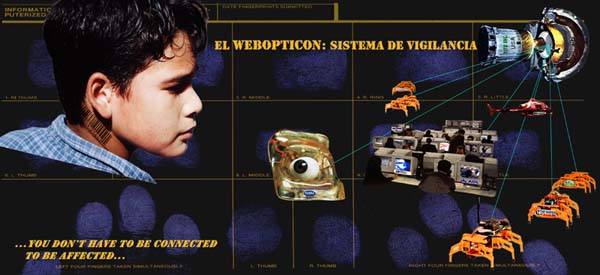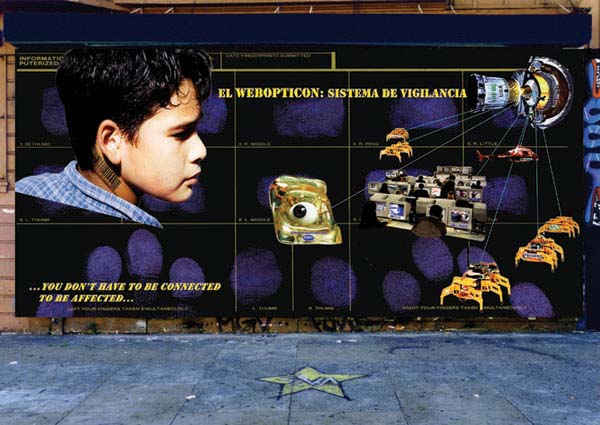
El Webopticon: Sistema de Vigilancia
Digital Mural by Los Cybrids
rené garcía-john jota leaños-mónica
praba pilar
Galería de la Raza 10' x 24' 2001
EL WEBOPTICON
The emergence of a technologically
driven surveillance society is the central issue of
El Webopticon digital mural on the wall of Galería
De La Raza. "Whether residents of Latino barrios
‘opt in’ or ‘opt out of computers
and the web, they are affected by privacy issues related
to information technology," reports Praba Pilar,
a member of Los Cybrids, the trio of cyber-critical
Latino artists responsible for the mural. "From
roadside fingerprint searches to your own DNA bar
code, police forces are gathering more and more data
on more and more people for instant identification," she adds.
Developed by the military in 1963
as ARPANET, the Internet has extended surveillance
into all areas of our lives. Extremely sophisticated
surveillance systems and robotic devices have been
developed in Silicon Valley and universities with
funding from DARPA, the Defense Advanced Research
Projects Agency. Eighteen states in the US operate
web sites that list the names, pictures, criminal
records and sentences for current inmates and those
on parole for public view. The website that the Florida
prison system maintains with inmate and parolee data
recorded more than 2.2 million hits in December of
2000. Maricopa County, Arizona offers 24 hour access
to its “jail cam”, where a person browsing
the web can actually view people being booked, searched,
processed and detained in county holding cells. More
and more states are promising to get these systems
online.
In the barrio, we see digital red-lining
by the police, as people are tracked before any crime
is committed. Not to be left behind in the information
age, cops brag about their mobile computing / wireless
data services units. Computers, cellular phones, PDAs,
and the world wide web provide the mechanism and network
for our fingerprints, DNA prints, police, FBI and
international police profiles, location tracking and
more to be sent out via satellites. Fingerprints,
which used to take weeks to confirm, can now be checked
roadside. Immigrants can now be instantly identified
through the INS’ biometric computer system IDENT,
with 227 terminals around the country that currently
contain fingerprints and pictures of nearly two million
people for instant digital identification.
Meanwhile, surveillance cameras are
all over public space, set up to not only recognize
people’s faces in the street, but to spot "abnormal"
behavior, such as moving too fast or too slow, or
lingering in a place for too long, and "predict" when a crime is about to be committed. We are constantly
being watched: on the street, at work, on public transit,
in schools and in government offices. We are further
watched through online monitoring of activity. And
it's gonna get worse: The Federation of American Scientists
reports that the US military is right now building
the most expensive program in the history of surveillance,
a $25 billion space satellite system for very detailed
surveillance known as Future Imagery Architecture.
It’s
the Webopticon, the policing device of the new international
e-con order, the latest weapon in the continuing war
on the poor and communities of color. The Bad news
is: you do not need to be connected, to be affected.
With so much talk about the digital divide, we need
more talk about this racial divide online and digital
convergence offline.

|

